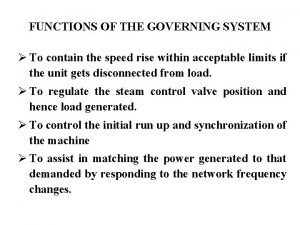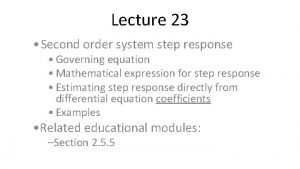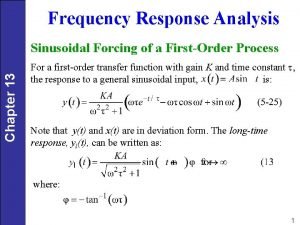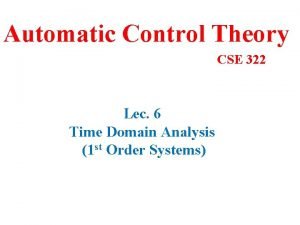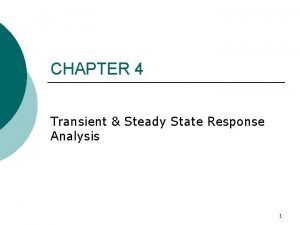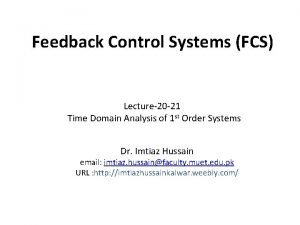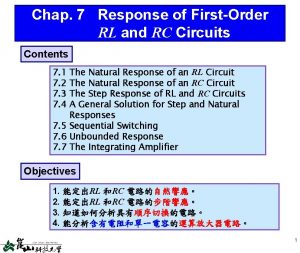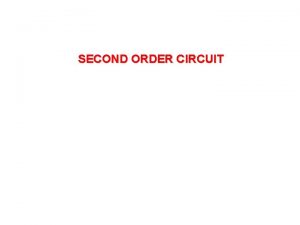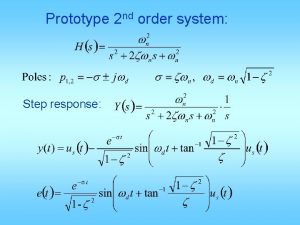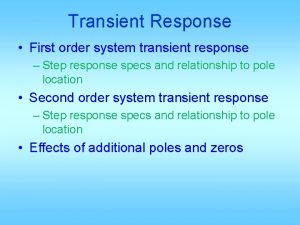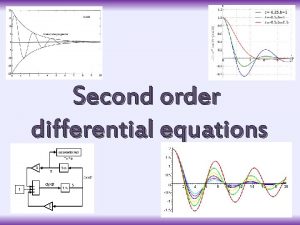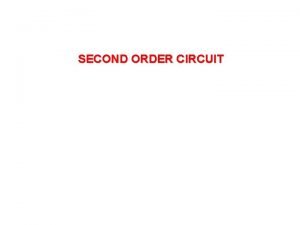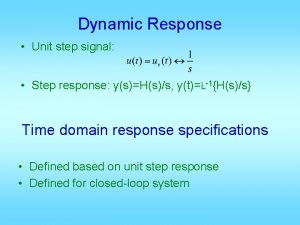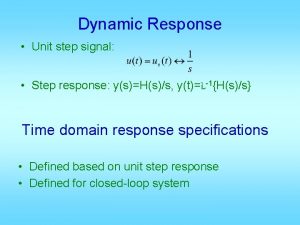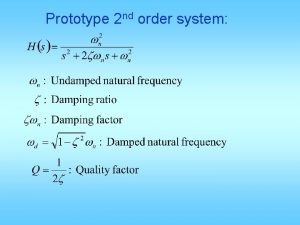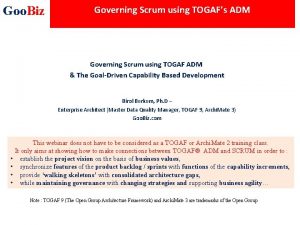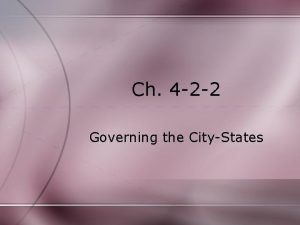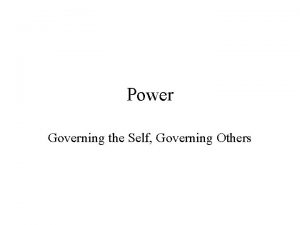Lecture 23 Second order system step response Governing























- Slides: 23

Lecture 23 • Second order system step response • Governing equation • Mathematical expression for step response • Estimating step response directly from differential equation coefficients • Examples • Related educational modules: –Section 2. 5. 5

Second order system step response • Governing equation in “standard” form: • Initial conditions: • We will assume that the system is initially “relaxed”

Second order system step response – continued • We will concentrate on the underdamped response: • Looks like the natural response superimposed with a step function

Step response parameters • We would like to get an approximate, but quantitative estimate of the step response, without explicitly determining y(t) • Several step response parameters are directly related to the coefficients of the governing differential equation • These relationships can also be used to estimate the differential equation from a measured step response • Model parameter estimation

Second order system step response – plot

Steady-state response • Input-output equation: • As t , circuit parameters become constant so: • Circuit DC gain:

• On previous slide, note that DC gain can be determined directly from circuit.

Rise time • Rise time is the time required for the response to get from 10% to 90% of yss • Rise time is closely related to the natural frequency:

Maximum overshoot, MP • MP is a measure of the maximum response value • MP is often expressed as a percentage of yss and is related directly to the damping ratio:

Maximum overshoot – continued • For small values of damping ratio, it is often convenient to approximate the previous relationship as:

Example 1 • Determine the maximum value of the current, i(t), in the circuit below

• In previous slide, outline overall approach: – Need MP, and steady-state value – Need damping ratio to get MP – Need natural frequency to get damping ratio – Need to determine differential equation

Step 1: Determine differential equation

Step 2: Identify n, , and steady-state current • Governing equation:

Step 3: Determine maximum current • Damping ratio, = 0. 54 • Steady-state current,

Example 2 • Determine the differential equation governing i. L(t) and the initial conditions i. L(0+) and vc(0+)

Example 2 – differential equation, t>0

Example 2 – initial conditions

Example 3 – model parameter estimation The differential equation governing a system is known to be of the form: When a 10 V step input is applied to the system, the response is as shown. Estimate the differential equation governing the system.

Example 3 – find tr, MP, yss from plot

Example 3 – find differential equation • From plot, we determined: – MP 0. 25 – tr 0. 05 – yss 0. 002

Example 4 – Series RLC circuit • MP 100%, n = 100, 000 rad/sec (16 KHz)

 Step 1 step 2 step 3 step 4
Step 1 step 2 step 3 step 4 Calculating overshoot
Calculating overshoot First-order and second-order change examples
First-order and second-order change examples First order cybernetics and second order cybernetics
First order cybernetics and second order cybernetics Chapter 15 musculoskeletal system practical
Chapter 15 musculoskeletal system practical Turbine stress evaluator
Turbine stress evaluator Function of governing system
Function of governing system Via optica
Via optica 01:640:244 lecture notes - lecture 15: plat, idah, farad
01:640:244 lecture notes - lecture 15: plat, idah, farad Second order system examples
Second order system examples Sinusoidal response of first order system
Sinusoidal response of first order system Parabolic response of first order system
Parabolic response of first order system Steady state response formula
Steady state response formula Parabolic response of 1st order system
Parabolic response of 1st order system 186 282 miles per second into meters per second
186 282 miles per second into meters per second Second step activation key
Second step activation key Second step social emotional skills for early learning
Second step social emotional skills for early learning Second step problem solving poster
Second step problem solving poster Natural response and forced response
Natural response and forced response What is natural response
What is natural response Primary immune response and secondary immune response
Primary immune response and secondary immune response Step response circuit
Step response circuit Rl circuit
Rl circuit Disking of teeth
Disking of teeth






